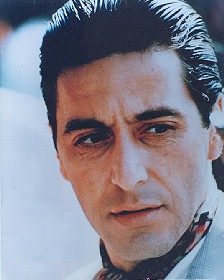Scott's key sentences, in an essay titled "Seen This Guy Lately?":
Mr. Pacino's more or less recent body of work — from "Sea of Love," the 1989 crime melodrama that marked his comeback as a movie star, through "People I Know" — may look, at first glance, like the usual screen actor's grab bag: high-concept studio pictures and quirky indie projects, genre exercises and improbable stunts, interesting mediocrities and a handful of rough gems. But there is also, beneath the surface diversity, a strange consistency, almost as if the individual roles were episodes in a single ongoing performance. Again and again, Mr. Pacino has chosen to explore the inner condition and outward behavior of a middle-aged man who lives haunted by the after-effects of a calamitous, generally self-inflicted defeat, someone who has survived his own moral or material failure and now must struggle to evade its deathly shadow. Sometimes these men find redemption, sometimes destruction. Occasionally they fumble toward love, though more typically it has long since slipped from their grasp. Their principal relationships tend to be with younger men (and occasionally, as with Hilary Swank's worshipful young cop in "Insomnia," with women) for whom the old-timers serve variously (sometimes simultaneously) as mentors, tormentors, confessors and role models.
But they are all, somehow, variations on a theme. Mr. Pacino has become, deliberately or not, our foremost cinematic embodiment of male midlife decay, exposing souls that have been betrayed, corrupted, worn down and otherwise damaged by weakness, hubris or the sheer ferocity of their own personalities.
Scott's essay accurately describes the condition, but does not much diagnose why Pacino's recent acting mostly consists "ravaged intensity" that often descends into "the crudest shtick".
Well, I've got a theory. It's not my own, but it makes a lot of sense: Al Pacino is almost sixty-four years old. Did you realize that? The theory is that he's had his face lifted so many times to keep looking younger that he can no longer do any kind of subtle facial gestures. He's lost the ability to furrow his brow, to communicate without words, and so the only acting tool left in his kit is his booming, melodramatic voice.
Take a look at these pictures -- one from The Godfather, Part II; the other a recent portrait. You tell me:


I think that forehead looks a little . . . smooth, don't you?
By the way, the whole Arts & Leisure section is great today, highlighted by a Frank Rich column on why Jon Stewart so owns this cultural moment and Todd Purdum's full-pager on the comedic legacy of Bob Hope, who turns 100 next month, despite all my predictions to the contrary. Congratulations and thank you, Jodi Kantor.

No comments:
Post a Comment